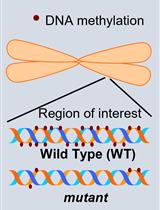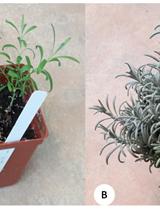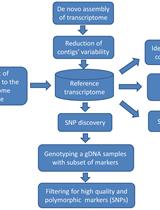- EN - English
- CN - 中文
Detection of Transposable Element Insertion Site Polymorphisms by Sequence-Specific Amplification Polymorphism (SSAP)
通过序列特异扩增多态性(SSAP)法检测转座子插入位点的多态性
发布: 2014年03月05日第4卷第5期 DOI: 10.21769/BioProtoc.1054 浏览次数: 11395
评审: Tie Liu

相关实验方案

利用Southern杂交技术研究植物中转座子DNA甲基化和拷贝数变异的情况
Vivek Hari Sundar G. and P. V. Shivaprasad
2022年06月05日 3069 阅读
Abstract
Transposable elements represent a major part of any eukaryotic genomes. Notably in plants they can account for more than 80% of the whole genomic sequence (such as in maize). Due to their mobility across the genome, they can act as mutagens but can also be considered as an important source of genetic diversity. It has been shown that they may be activated following various stresses, and it has been assumed that they may contribute to genome evolution and adaptation. Molecular methods have thus been proposed to allow identification of new transposition events, or more generally to tag transposable element insertion site polymorphisms. Sequence-Specific Amplification Polymorphism (SSAP) is a high throughput method derived from AFLP, which has been first tested on the barley genome (Waugh et al., 1997). Its efficiency in tagging TEs in comparison to AFLP is based on the use of specific primers anchored in the TE sequences of interest, requiring the TEs under survey to be previously characterized. SSAP can thus be used to identify any genomic reorganization in the vicinity of TE insertion sites, and still represents an efficient approach to analyse evolutionary dynamics of TEs.
Keywords: Allopolyploidy (异源多倍体)Materials and Reagents
- Restriction of genomic DNA using endonucleases
- Genomic DNAs from the samples to be analysed at concentrations of 100 ng/µl.
- Endonuclease enzyme insensitive to DNA methylation, generating cohesive ends
Note: TE sequence ends have to be devoid of any corresponding restriction sites.
- Genomic DNAs from the samples to be analysed at concentrations of 100 ng/µl.
- Adapter ligation
- Two oligonucleotides which form a double-stranded adapter, with an overhang complementary to the overhang left by the restriction enzyme used. In the case of EcoRI (Thermo Fisher Scientific, Fermentas) the 5’ overhang is AATT and the oligonucleotide sequences are 5’-CTCGTAGACTGCGTACC-3’ and 5’-AATTGGTACGCAGTCTAC-3’. Annealing of the two oligonucleotides will constitute the adapter (purple rectangles in Figure 1).
- T4 DNA ligase (1-3 U/μl) with the corresponding ligase buffer (Promega Corporation, catalog number: M1801 )
- Sterile ultrapure water
- Two oligonucleotides which form a double-stranded adapter, with an overhang complementary to the overhang left by the restriction enzyme used. In the case of EcoRI (Thermo Fisher Scientific, Fermentas) the 5’ overhang is AATT and the oligonucleotide sequences are 5’-CTCGTAGACTGCGTACC-3’ and 5’-AATTGGTACGCAGTCTAC-3’. Annealing of the two oligonucleotides will constitute the adapter (purple rectangles in Figure 1).
- Pre-amplification
- PCR reagents
- Homemade Taq DNA polymerase is of sufficient quality for the PCR reactions but Taq Promega has also been used (Promega corporation, catalog number: M8301 ) with the corresponding Taq polymerase buffer.
- 25 mM MgCl2
- dNTPs (10 µM each)
- Homemade Taq DNA polymerase is of sufficient quality for the PCR reactions but Taq Promega has also been used (Promega corporation, catalog number: M8301 ) with the corresponding Taq polymerase buffer.
- Pre-amplification primers (10 μM each)
- One primer is anchored in the adapter: 5’-GACTGCGTACCAATTC-3’ (primer P1 in Figure 1).
- The other primer is anchored in the TE of interest, close to its end to limit the size of amplicon (primer P2 in Figure 1).
- One primer is anchored in the adapter: 5’-GACTGCGTACCAATTC-3’ (primer P1 in Figure 1).
- PCR reagents
- Selective amplification
- PCR reagents (see pre-amplification step)
- Selective amplification primers (10 μM each)
- One primer is anchored in the adapter, with the addition of 3 nucleotides at the 3’ end (primer P3 in Figure 1) to limit the number of bands to be visualized and analyzed by gel electrophoresis. Several combinations of A, T, G and C should be used to target different genomic localizations of TE insertion sites.
- The other primer is defined to perform a nested PCR in comparison with the pre-amplification step (primer P4 in Figure 1); this primer is labelled with a 5’-IRDye. DNA labelled with IRDye (infrared dye) has to be stored in the dark at -20 °C. To minimize exposure to light, wrap the tube in aluminium foil.
- One primer is anchored in the adapter, with the addition of 3 nucleotides at the 3’ end (primer P3 in Figure 1) to limit the number of bands to be visualized and analyzed by gel electrophoresis. Several combinations of A, T, G and C should be used to target different genomic localizations of TE insertion sites.
- PCR reagents (see pre-amplification step)
- Acrylamide gel for SSAP profile analysis
- Kimwipes
- Urea (Merck KGaA, catalog number: 1.08488.1000 )
- Long Ranger Acrylamide (50%) (Lonza, catalog number: 50611 )
- APS (Bio-Rad Laboratories, catalog number: 161-0700 )
- Temed (Bio-Rad Laboratories, catalog number: 161-0801 )
- Absolute ethanol
- Formamide (Sigma-Aldrich, catalog number: F9037 )
- 10x TBE buffer (Tris/Borate/EDTA) (see Recipes)
- 5.5% acrylamide gel (see Recipes)
- Loading buffer (see Recipes)
- Kimwipes
Equipment
- 1.5 ml Eppendorf tubes
- Centrifuge
- Parafilm
- Incubator or oven
- Water bath
- 96-well PCR plates
- 0.45 μm filters
- LI-COR DNA analyzer (LI-COR) and corresponding equipment (plates, combs, spacers...)
- Thermal cycler
- Horizontal shaker
Procedure
文章信息
版权信息
© 2014 The Authors; exclusive licensee Bio-protocol LLC.
如何引用
Sarilar, V., Palacios, P. M. and Alix, K. (2014). Detection of Transposable Element Insertion Site Polymorphisms by Sequence-Specific Amplification Polymorphism (SSAP). Bio-protocol 4(5): e1054. DOI: 10.21769/BioProtoc.1054.
分类
植物科学 > 植物分子生物学 > DNA > 基因分型
系统生物学 > 基因组学 > 转座子
分子生物学 > DNA > 基因分型
您对这篇实验方法有问题吗?
在此处发布您的问题,我们将邀请本文作者来回答。同时,我们会将您的问题发布到Bio-protocol Exchange,以便寻求社区成员的帮助。
提问指南
+ 问题描述
写下详细的问题描述,包括所有有助于他人回答您问题的信息(例如实验过程、条件和相关图像等)。
Share
Bluesky
X
Copy link










